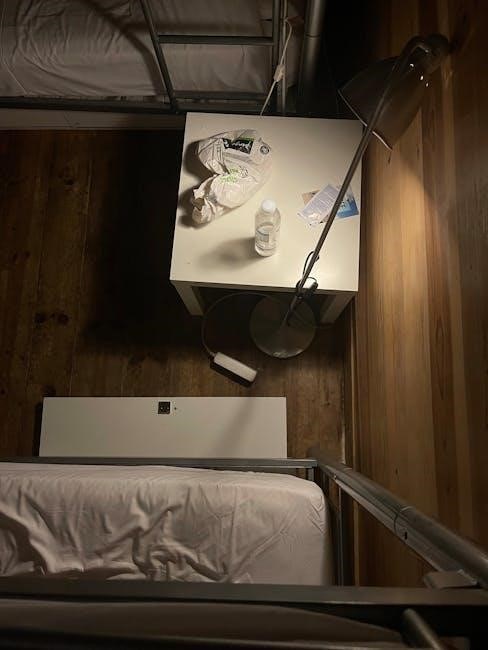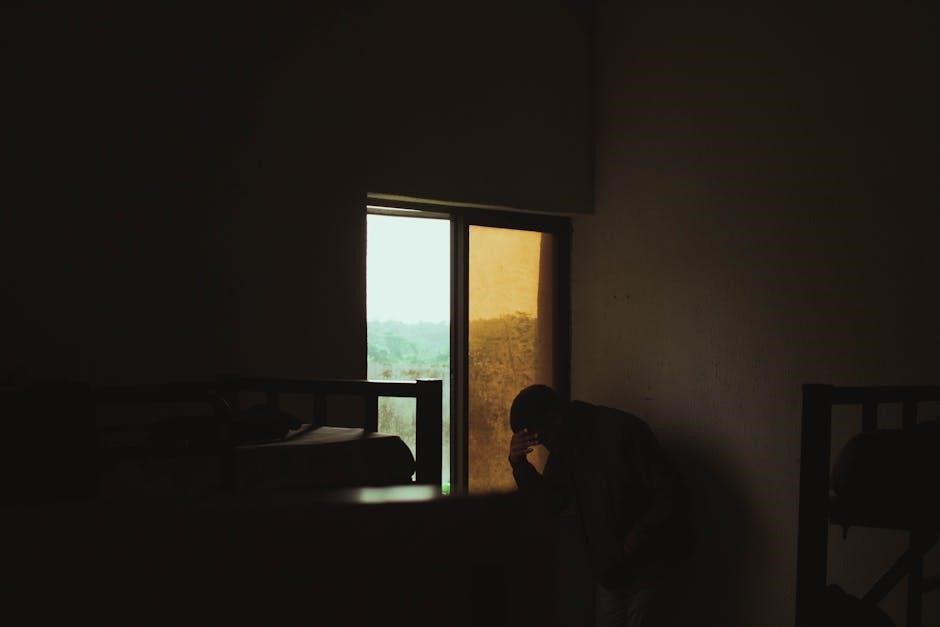Assembling a bunk bed can be a rewarding project, offering space-saving solutions and functionality for any room. This guide provides step-by-step instructions to ensure safety, durability, and a successful assembly process. Gather tools, follow the manual, and take your time to build a sturdy bunk bed for years of use.
Understanding the Importance of Proper Assembly
Proper assembly of a bunk bed is crucial for ensuring safety, stability, and durability. A well-assembled bed prevents structural weaknesses, such as wobbling or collapsing, which can lead to accidents. Secure joints and properly tightened bolts are essential to support the weight of users and maintain the bed’s integrity. Improper assembly can result in loose connections over time, compromising safety and requiring costly repairs. Additionally, correct assembly ensures compliance with weight limits, preventing potential breakage. Taking the time to follow instructions carefully and double-checking all connections helps avoid future issues, ensuring the bunk bed remains a safe and reliable piece of furniture for years to come.
Gathering Necessary Tools and Materials
Gathering the right tools and materials is the first step in a successful bunk bed assembly. Typically, you’ll need a screwdriver, Allen wrench, and wrench for bolts. Check the instruction manual for specific tools required, as some beds may need specialized fasteners. Ensure all hardware, like screws, bolts, and washers, is accounted for. Organizing components, such as frames, rails, and ladders, in a clear workspace prevents confusion. Having a tape measure handy helps verify dimensions. Double-checking the inventory against the parts list ensures nothing is missing. A well-prepared workspace with all tools and materials within reach streamlines the assembly process, saving time and reducing frustration, leading to a stress-free building experience.
Preparation for Assembly
Preparation is key to smooth and efficient bunk bed assembly. Clear a spacious workspace, ensuring all components are accessible and organized neatly, minimizing delays and confusion during assembly.
Unpacking and Organizing Components
Unpacking and organizing components is the first critical step in bunk bed assembly. Carefully remove all items from the boxes and lay them out in a clear workspace. Separate hardware like screws, bolts, and Allen wrenches, placing them in labeled containers for easy access. Check each part against the inventory list provided in the manual to ensure nothing is missing or damaged. This step prevents delays and ensures that assembly proceeds smoothly. Additionally, organizing parts by size and type helps in quickly locating them when needed, saving time and reducing frustration during the assembly process.
Reading and Interpreting the Instruction Manual
Thoroughly reading and interpreting the instruction manual is essential for successful bunk bed assembly. Begin by skimming the manual to understand the overall process and identify safety precautions. Pay close attention to diagrams and labeled parts, as they provide visual guidance. Highlight or underline key steps to ensure clarity. Double-check the list of required tools and materials to confirm you have everything needed. If instructions are unclear, refer to online resources or manufacturer support for clarification. Avoid skipping steps, as this can lead to misassembly. Taking the time to understand the manual ensures a smooth and safe assembly process.

Step-by-Step Assembly Process
Start by assembling the base frame using the provided screws and bolts. Attach the side rails and slats to create a sturdy foundation; Follow the manual’s sequence to ensure alignment and stability. Use a wrench or screwdriver for tight connections. Double-check each step to avoid errors. Proceed to attach the ladder and safety railings, ensuring they are secure. Finally, place the mattresses and test the bed’s stability before use.
Building the Bed Frame
Begin by laying out the frame components on a flat surface. Use the Allen wrench to secure the side rails to the head and footboards. Tighten all bolts firmly. Next, attach the support slats to the frame, ensuring they are evenly spaced for mattress support. Double-check the alignment using the instruction manual. Once the base is stable, move on to constructing the upper bunk. Repeat the process for the second frame, ensuring it matches the first in size and structure. Use clamps to hold pieces in place while tightening. A sturdy frame is essential for safety and durability.
Attaching the Ladder and Safety Railings
Secure the ladder to the bunk bed frame using the provided bolts. Ensure it is tightly fastened to the upper bunk for safe access. Install safety railings around the upper bunk to prevent falls. Attach them firmly to the frame, checking for stability. Tighten all screws and bolts thoroughly. Make sure the ladder is positioned at a comfortable angle and the railings are evenly spaced. Double-check the ladder’s stability and the railings’ alignment with the mattress. Proper installation of these components is crucial for ensuring the bunk bed’s safety and durability. Always follow the manufacturer’s instructions for precise assembly.
Safety Tips and Considerations
Ensure the bunk bed is stable and secure to prevent accidents. Always follow assembly instructions precisely and double-check all connections for tightness. Regular inspections are essential to maintain safety and durability over time.
Ensuring Stability and Structural Integrity
Stability is crucial for bunk bed safety. Begin by ensuring all frames are level and properly aligned. Use a spirit level to confirm even placement, especially on uneven floors. Tighten all bolts and screws firmly, but avoid overtightening, which can damage the material. Double-check the weight capacity specified in the manual to ensure it meets your needs. Additionally, secure the bed to the wall using provided brackets to prevent tipping. Regularly inspect the joints and connections for any signs of wear or loosening. A sturdy and well-maintained bunk bed ensures a safe and comfortable sleeping environment for years to come.
Securing the Bunk Bed to the Wall
Securing the bunk bed to the wall is essential for preventing accidental tipping. Locate the wall studs behind the bed using a stud finder. Attach the provided safety brackets to the bed frame and drill screws into the studs for a secure hold. Ensure the brackets are tightly fastened and aligned properly. For added stability, consider using anti-tip brackets specifically designed for bunk beds. Regularly inspect the brackets and screws for any signs of wear or loosening. This step significantly enhances safety, especially for children, and provides peace of mind for parents. Always follow the manufacturer’s guidelines for wall securing to ensure maximum safety and structural integrity.

Troubleshooting Common Issues
Identify and resolve common assembly issues promptly to ensure safety and functionality. Check for misaligned parts, loose connections, and missing components. Use the manual as a guide to address problems effectively.
Addressing Missing or Damaged Parts
If you encounter missing or damaged components during assembly, stop immediately. Contact the manufacturer or supplier for replacements. Check the instruction manual for part numbers and descriptions. Ensure all pieces are in good condition before proceeding. Damaged parts can compromise the bed’s stability and safety. Always verify the completeness of your kit before starting. If unsure, refer to the troubleshooting section of the manual for guidance. Properly addressing these issues ensures a secure and durable bunk bed structure for years of reliable use. Safety should never be compromised by using damaged or incomplete components.
Fixing Misaligned or Loose Connections
Ensure all bolts and screws are tightened securely to maintain structural integrity. If connections feel loose, re-tighten using a wrench or screwdriver. For misaligned parts, gently adjust the components before securing. Double-check each joint for proper alignment. If a part remains misaligned, disassemble and reattach following the manual. Avoid over-tightening, which can damage the material. Regularly inspect connections over time to prevent loosening due to use. Properly aligned and secure connections are crucial for the bed’s stability and safety, ensuring it can withstand daily wear and tear without compromising its durability or structural integrity.

Final Touches and Inspection
After assembly, inspect the bunk bed thoroughly. Ensure all screws and bolts are tightened. Test the bed’s stability by gently rocking it. Check for any wobbling or loose parts. Make sure the ladder is secure and safety railings are properly attached. Double-check that all components are correctly aligned and fitted. Finally, test the bed by applying weight gradually to ensure it holds firm. This final inspection guarantees safety and durability, providing peace of mind for years of reliable use.
Double-Checking All Bolts and Screws
Once the bunk bed is assembled, it’s crucial to double-check every bolt and screw for tightness. Use a wrench or screwdriver to ensure no connections are loose. Pay particular attention to weight-bearing areas like the frame joints and ladder attachments. Tightening any loose fasteners will prevent instability. Additionally, verify that all hardware is correctly positioned and not over-tightened, as this could damage the material. This step is essential for ensuring the bed’s stability and safety, especially for children. A thorough check guarantees the bed will withstand daily use and provide a secure sleeping environment for years to come.
Testing the Bed for Safety and Durability

After assembly, test the bunk bed rigorously to ensure safety and durability. Start by gently rocking the structure to check for stability. Apply moderate weight to each level, simulating typical use. Ensure the ladder feels sturdy and the safety railings are secure. Check for any wobbling or creaking sounds, which could indicate loose parts. Additionally, inspect the bed’s frame for any signs of stress or damage. Testing helps identify potential issues before they become hazards. This step guarantees the bed meets safety standards and provides a reliable, long-lasting solution for users.

